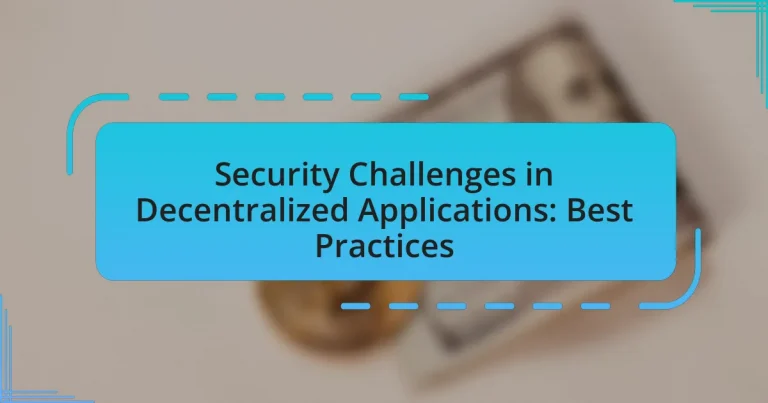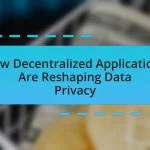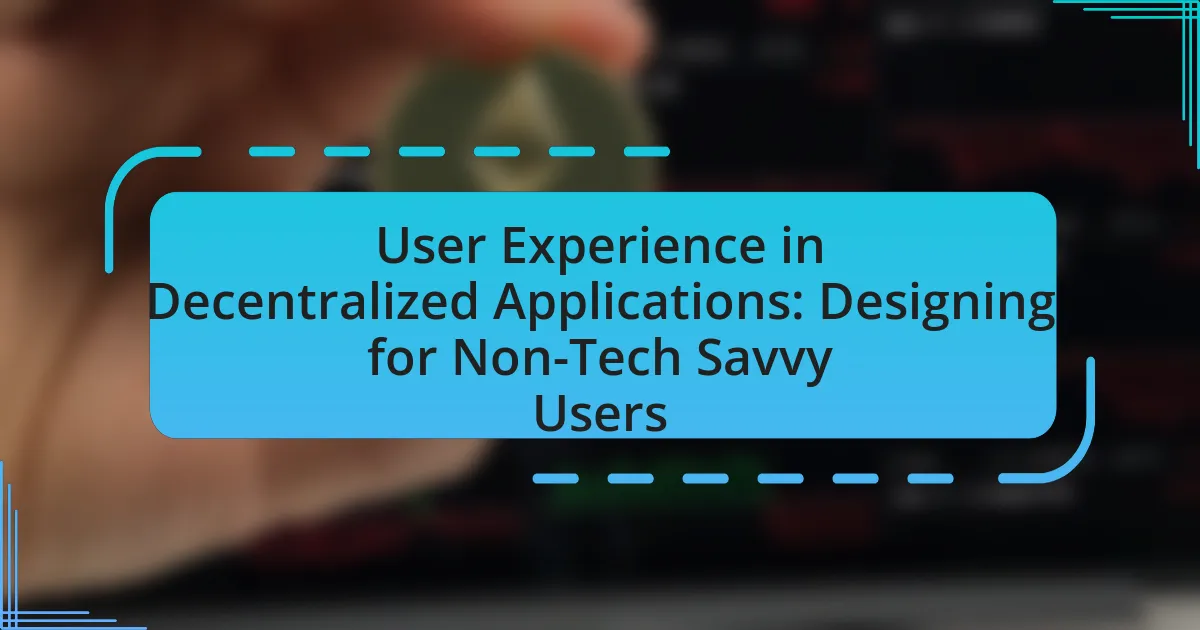Decentralized applications (dApps) face significant security challenges, including vulnerabilities in smart contracts, data privacy concerns, and susceptibility to network attacks. Key issues such as coding errors in smart contracts can lead to substantial financial losses, as demonstrated by the DAO hack in 2016. User behavior also plays a critical role in security, with poor practices increasing the risk of breaches. To mitigate these risks, best practices such as conducting thorough security audits, implementing secure coding techniques, and promoting user awareness are essential. This article outlines the various security threats to decentralized applications and provides actionable strategies for developers and users to enhance security and protect sensitive information.
What are the Security Challenges in Decentralized Applications?
Decentralized applications face several security challenges, including smart contract vulnerabilities, data privacy issues, and network attacks. Smart contracts can contain coding errors or logic flaws that attackers exploit, leading to financial losses; for instance, the DAO hack in 2016 resulted in a loss of $60 million due to a vulnerability in the smart contract code. Data privacy is compromised as decentralized systems often require public access to data, making sensitive information susceptible to exposure. Additionally, decentralized networks can be targeted by Distributed Denial of Service (DDoS) attacks, which disrupt service availability. These challenges necessitate robust security practices to mitigate risks effectively.
Why are decentralized applications vulnerable to security threats?
Decentralized applications are vulnerable to security threats primarily due to their reliance on smart contracts and the complexity of their underlying code. Smart contracts, which automate transactions and processes, can contain bugs or vulnerabilities that malicious actors exploit. For instance, the DAO hack in 2016, where an attacker exploited a vulnerability in the smart contract code, resulted in the loss of $60 million worth of Ether. Additionally, the decentralized nature of these applications often leads to a lack of oversight and auditing, making it easier for security flaws to go unnoticed. Furthermore, users may fall victim to phishing attacks or social engineering, as decentralized applications often require users to manage their own private keys, increasing the risk of unauthorized access.
What types of attacks are most common in decentralized applications?
The most common types of attacks in decentralized applications include smart contract vulnerabilities, Sybil attacks, and Distributed Denial of Service (DDoS) attacks. Smart contract vulnerabilities arise from coding errors or flaws, which can be exploited to manipulate contract behavior, as evidenced by the DAO hack in 2016 that resulted in a loss of $60 million. Sybil attacks involve an adversary creating multiple identities to gain disproportionate influence over the network, undermining trust and consensus mechanisms. DDoS attacks target the network’s availability by overwhelming it with traffic, disrupting services and operations. These attack vectors highlight the critical security challenges faced by decentralized applications.
How do vulnerabilities in smart contracts impact security?
Vulnerabilities in smart contracts significantly compromise security by allowing malicious actors to exploit flaws for unauthorized access or manipulation of assets. For instance, the DAO hack in 2016, which resulted in a loss of $60 million worth of Ether, exemplifies how a reentrancy vulnerability can be exploited to drain funds from a contract. Such vulnerabilities can lead to financial losses, loss of user trust, and potential regulatory scrutiny, highlighting the critical need for rigorous testing and auditing of smart contracts before deployment.
What role does user behavior play in the security of decentralized applications?
User behavior significantly impacts the security of decentralized applications by influencing how vulnerabilities are exploited. For instance, users who engage in risky practices, such as sharing private keys or using weak passwords, can inadvertently compromise the security of the application. Research indicates that human error accounts for a substantial percentage of security breaches; a study by the Ponemon Institute found that 95% of cybersecurity incidents are due to human mistakes. Therefore, promoting secure user practices is essential for enhancing the overall security posture of decentralized applications.
How can poor user practices lead to security breaches?
Poor user practices can lead to security breaches by creating vulnerabilities that malicious actors can exploit. For instance, weak passwords, such as “123456” or “password,” are easily guessable and can allow unauthorized access to sensitive information. According to a study by SplashData, over 10 million leaked passwords revealed that common passwords are still widely used, highlighting the risk associated with poor password management. Additionally, failing to update software regularly can leave systems exposed to known vulnerabilities; the 2020 Microsoft Exchange Server hack exemplifies how unpatched software can be exploited. Furthermore, users who fall for phishing attacks by clicking on suspicious links can inadvertently provide attackers with access to their accounts. The Anti-Phishing Working Group reported that phishing attacks increased by 220% in 2020, underscoring the impact of user negligence on security. Overall, poor user practices significantly increase the likelihood of security breaches by enabling attackers to exploit easily avoidable weaknesses.
What measures can users take to enhance their security?
Users can enhance their security by implementing strong, unique passwords for each account and enabling two-factor authentication (2FA) wherever possible. Strong passwords should be at least 12 characters long, combining letters, numbers, and symbols, which significantly reduces the risk of unauthorized access. According to a study by the National Institute of Standards and Technology (NIST), using 2FA can block 99.9% of automated attacks, making it a critical measure for securing accounts. Additionally, users should regularly update their software and applications to protect against vulnerabilities, as outdated systems are often targeted by cybercriminals.
What Best Practices Can Mitigate Security Risks in Decentralized Applications?
Implementing robust security practices is essential to mitigate risks in decentralized applications. Key best practices include conducting thorough security audits, utilizing formal verification methods, and ensuring secure coding practices. Security audits identify vulnerabilities in the code, while formal verification mathematically proves the correctness of algorithms, reducing the likelihood of exploits. Secure coding practices, such as input validation and error handling, prevent common vulnerabilities like injection attacks. According to a report by the Blockchain Security Alliance, 70% of security incidents in decentralized applications stem from coding errors, highlighting the importance of these practices.
How can developers ensure secure coding practices?
Developers can ensure secure coding practices by adhering to established security guidelines and frameworks, such as the OWASP Top Ten. These guidelines provide a comprehensive list of common vulnerabilities and best practices for mitigating them. For instance, implementing input validation and sanitization can prevent injection attacks, which are among the most prevalent security threats. According to the OWASP Foundation, 94% of web applications are vulnerable to such attacks, highlighting the necessity of these practices. Additionally, conducting regular code reviews and security testing, including static and dynamic analysis, further strengthens the security posture of applications by identifying potential vulnerabilities early in the development process.
What are the key principles of secure coding for decentralized applications?
The key principles of secure coding for decentralized applications include input validation, proper access control, and secure data storage. Input validation ensures that all user inputs are checked for correctness and safety, preventing injection attacks and other vulnerabilities. Proper access control mechanisms restrict user permissions based on roles, ensuring that only authorized users can perform sensitive actions. Secure data storage involves encrypting sensitive information both at rest and in transit, protecting it from unauthorized access and breaches. These principles are essential to mitigate risks associated with decentralized applications, which often operate in a trustless environment where security vulnerabilities can lead to significant financial losses and data breaches.
How can code audits and reviews improve security?
Code audits and reviews improve security by systematically identifying vulnerabilities and weaknesses in the codebase before deployment. These processes involve thorough examination by experienced professionals who can detect issues such as insecure coding practices, potential exploits, and compliance with security standards. For instance, a study by the University of California, Berkeley, found that code reviews can reduce the number of security vulnerabilities by up to 50%, demonstrating their effectiveness in enhancing software security.
What security measures should be implemented during the development lifecycle?
Security measures that should be implemented during the development lifecycle include threat modeling, secure coding practices, regular security testing, and continuous monitoring. Threat modeling helps identify potential security risks early in the development process, allowing teams to address vulnerabilities proactively. Secure coding practices, such as input validation and proper error handling, reduce the likelihood of introducing security flaws. Regular security testing, including static and dynamic analysis, ensures that vulnerabilities are detected and remediated before deployment. Continuous monitoring post-deployment allows for the detection of new threats and vulnerabilities, ensuring ongoing security. These measures are essential for mitigating risks associated with decentralized applications, which often face unique security challenges.
How can threat modeling be used to identify potential vulnerabilities?
Threat modeling can be used to identify potential vulnerabilities by systematically analyzing the security risks associated with a system’s architecture and design. This process involves identifying assets, potential threats, and vulnerabilities, allowing teams to prioritize security measures based on the likelihood and impact of various attack scenarios. For instance, the STRIDE framework categorizes threats into Spoofing, Tampering, Repudiation, Information Disclosure, Denial of Service, and Elevation of Privilege, providing a structured approach to uncovering weaknesses. By employing threat modeling, organizations can proactively address security gaps before they are exploited, thereby enhancing the overall security posture of decentralized applications.
What role does continuous monitoring play in maintaining security?
Continuous monitoring is essential for maintaining security as it enables real-time detection of vulnerabilities and threats. By consistently analyzing system activities and user behaviors, organizations can identify anomalies that may indicate security breaches. For instance, a study by the Ponemon Institute found that organizations with continuous monitoring capabilities can reduce the average time to detect a breach from 206 days to just 66 days, significantly minimizing potential damage. This proactive approach not only enhances incident response but also supports compliance with security regulations, ensuring that systems remain resilient against evolving threats.
How Can Users Protect Themselves When Using Decentralized Applications?
Users can protect themselves when using decentralized applications by employing strong security practices such as using hardware wallets, enabling two-factor authentication, and being cautious with permissions. Hardware wallets provide a secure way to store private keys offline, significantly reducing the risk of hacking. Enabling two-factor authentication adds an extra layer of security, making unauthorized access more difficult. Additionally, users should carefully review the permissions requested by decentralized applications, as excessive permissions can lead to potential security vulnerabilities. These practices are essential for mitigating risks associated with decentralized applications, which often lack centralized oversight and can expose users to various threats.
What are the best practices for users to enhance their security?
To enhance their security, users should implement strong, unique passwords for each account and enable two-factor authentication (2FA) wherever possible. Strong passwords typically consist of at least 12 characters, including a mix of letters, numbers, and symbols, which significantly reduces the risk of unauthorized access. According to a study by the National Institute of Standards and Technology (NIST), using 2FA can prevent up to 99.9% of automated attacks, making it a critical practice for securing accounts. Additionally, users should regularly update their software and applications to protect against vulnerabilities, as outdated software is a common target for cyberattacks.
How can users safely manage their private keys?
Users can safely manage their private keys by employing hardware wallets, which store keys offline and provide enhanced security against online threats. Hardware wallets, such as Ledger and Trezor, are designed to keep private keys isolated from internet-connected devices, significantly reducing the risk of hacking. Additionally, users should enable two-factor authentication (2FA) on any service that supports it, adding an extra layer of protection. Regularly updating software and using strong, unique passwords further fortifies security. According to a report by the Cybersecurity & Infrastructure Security Agency (CISA), using hardware wallets and 2FA can mitigate risks associated with key management, making them effective strategies for safeguarding private keys.
What precautions should users take when interacting with decentralized applications?
Users should take several precautions when interacting with decentralized applications to ensure their security and privacy. First, they should verify the legitimacy of the application by checking its code and reviews, as many decentralized applications can be susceptible to scams or vulnerabilities. Additionally, users must utilize secure wallets and enable two-factor authentication to protect their private keys and sensitive information.
Moreover, users should be cautious about sharing personal information and avoid connecting their wallets to untrusted platforms. Regularly updating software and being aware of phishing attempts are also critical steps to mitigate risks. According to a report by the Blockchain Security Alliance, 70% of security breaches in decentralized applications stem from user negligence, highlighting the importance of these precautions.
What tools and resources are available for improving security in decentralized applications?
To improve security in decentralized applications, developers can utilize tools such as smart contract auditing services, security libraries, and decentralized identity solutions. Smart contract auditing services, like OpenZeppelin and ConsenSys Diligence, provide thorough reviews of code to identify vulnerabilities before deployment. Security libraries, such as the OpenZeppelin Contracts library, offer pre-audited code components that help mitigate common security risks. Additionally, decentralized identity solutions, like uPort and SelfKey, enhance user authentication and data privacy, reducing the risk of unauthorized access. These resources collectively contribute to a more secure environment for decentralized applications.
Which security tools are recommended for developers and users?
Recommended security tools for developers and users include static application security testing (SAST) tools like SonarQube, dynamic application security testing (DAST) tools such as OWASP ZAP, and dependency scanning tools like Snyk. These tools help identify vulnerabilities in code, assess runtime security, and manage third-party library risks, respectively. For instance, SonarQube analyzes source code for vulnerabilities and code quality, while OWASP ZAP simulates attacks to find security flaws in running applications. Snyk focuses on identifying vulnerabilities in open-source dependencies, which is crucial for maintaining secure decentralized applications.
How can community resources contribute to better security practices?
Community resources enhance security practices by providing access to shared knowledge, tools, and support networks. These resources, such as local cybersecurity groups, online forums, and educational workshops, facilitate the exchange of best practices and threat intelligence among users. For instance, community-led initiatives like the Cybersecurity Awareness Month promote awareness and training, leading to improved security behaviors among participants. Additionally, collaboration within communities can lead to the development of open-source security tools, which are often more transparent and scrutinized than proprietary solutions, thereby increasing trust and effectiveness in security measures.
What are the common troubleshooting steps for security issues in decentralized applications?
Common troubleshooting steps for security issues in decentralized applications include conducting a thorough code review, implementing robust access controls, and utilizing automated security testing tools. A code review helps identify vulnerabilities such as improper input validation or insecure coding practices, which are critical in decentralized environments where trust is minimized. Implementing access controls ensures that only authorized users can interact with the application, reducing the risk of unauthorized access or data breaches. Automated security testing tools, such as static and dynamic analysis tools, can continuously scan the application for known vulnerabilities, providing real-time feedback and enhancing overall security posture. These steps are essential for maintaining the integrity and security of decentralized applications.





